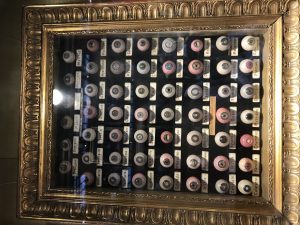Musee d’Histoire de la Medicine was established in 1905, added as a wing to the Collège de Chirurgie by architect Ginain. The museum possesses a large variety of medicinal tools, machines, writings, among other interesting medically-related items. The most ancient of items included an Egyptian form of “Sunglasses” to “scalpels” from the Roman empire. The medicinal equipment was extensive, spanning primitive forms of surgical tools, such as saws for amputations, to the first-forms of autoclaves and electrical therapy machines for depression. Passing by the surgical tools, I realized much of today’s modern medicine has made few advances in areas such as surgical tools or eye protection to name a few examples. The shapes of the blade used for surgery in the medieval ages were sometimes identical to the ones we use now, especially for orthopedic-based tools.
One of the craziest stories we were told was about Louis the 14th, who contracted a myriad of diseases and ailments throughout his 76 years of life. He even once developed a fatal anal fistula. Unfortunately, the surgery for this problem had not yet been perfected. Before the king could be operated on, numerous individuals were tested on first, so the surgeon could improve his performance before cutting into the king. There existed a hierarchy of treatment, wherein the most high-ranking individual received the best treatment and the lowest-ranking individuals received experimental and sub-par treatment. While these issues have been resolved such that in today’s science it is unethical to subject any person to that degree of experimentation and forceful experimentation is not permitted, problems with access to quality treatment is still present across socioeconomic strata. One study found that women in lower socioeconomic positions were more at risk for migraine (Stewart et. al., 2013). Another study showed higher childhood and adulthood socioeconomic context were correlated with better auditory verbal learning test recognition, and higher childhood residential mobility was associated with higher crystalized intelligence. Midlife higher SEC was correlated with faster and better task switching (Scott et. al., 2018). There are clear existent socioeconomic implications in neuroscience and medicine today.


The most relevant trend I found in the museum was in the history that so clearly reflected how the best medicine has always been first served to those with the most wealth and highest social standing. The majority of these inequities stemmed from the clearly hierarchical social systems of ancient civilizations. Those dynamics have followed us into our present where a plethora of poor health outcomes can only be explained by socioeconomics.
Works Cited
Scott, A., Reed, R., Garcia-Willingham, N., Lawrence, K. and Segerstrom, S. (2018). Lifespan Socioeconomic Context: Associations with Cognitive Functioning in Later Life. The Journals of Gerontology: Series B.
Stewart, W., Roy, J. and Lipton, R. (2013). Migraine prevalence, socioeconomic status, and social causation. Neurology, 81(11), pp.948-955.
